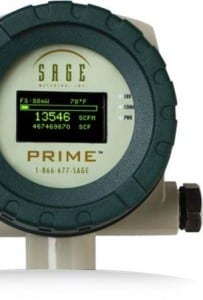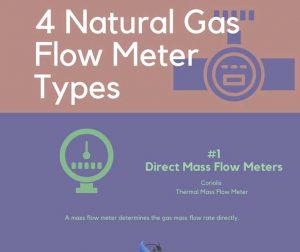In part VI of my series on natural gas flow meter types, I discuss the thermal mass flow meter, considered one of the four new-technology flowmeters.
Natural Gas Flow Measurement
I shared information on other gas meters in earlier posts, including Coriolis meters, diaphragm meters, rotary meters, ultrasonic meters, and turbine flowmeters. Sage Metering manufactures high-performance thermal mass flow meters that measure gas mass flow.
The thermal mass flow meter is considered one of the new-technology flow meters, part of a small group consisting of Coriolis, magnetic, ultrasonic, and vortex meters. These devices were introduced after 1950 and have been in a rapid product development era and high growth mode. According to a recent study by Flow Research, this market will grow approximately 7.5% through 2018, with the fastest growth in developing-Asian countries, China, and the Middle East.

Thermal Mass Flow Meter
Thermal flow meters measure mass flow, not volumetric flow, and use heat to compute the measurement. Unlike the Coriolis meter, which relies on fluid momentum, the thermal mass flow meter depends on the gas’s heat-conducting or thermal properties. There are two different ways of measuring how heat disperses. One method is called the “constant temperature differential,” while the other is the “constant current” process. Both ways rely on the principle that higher velocity flow brings more cooling in the flow stream.
There are two sensors in the constant temperature differential mode, a heated sensor and a second sensor, which measures the gas temperature. Mass flow is calculated based on the electrical power needed to maintain a constant temperature between the sensors.
There is also a heated sensor and a second sensor in the constant current mode, which senses the gas flow temperature. In this method, the power to the heated sensor is constant, and mass flow is calculated based on the temperature difference between the sensors.
Advantages
This meter style excels in low-flow applications and has a fast response time. The thermal meter can measure low-pressure gases that the Coriolis meter cannot quantify. It is ideal for emissions monitoring and stack flow measurement. The meters are also available in insertion-style models, facilitating larger pipe-size measurement applications. They also have a relatively low cost compared to the other meter alternatives. Take a look at the 9 Advantages of Thermal Mass Flow Meters.
Disadvantages
Thermal mass flow meters are mainly used to measure a gas flow of known gas composition and work in a few liquid applications. They cannot measure steam, and accuracy varies depending on the manufacturer. On average, they are 1%–5% accurate, with the Sage thermal mass meter’s flow accuracy being +/- 0.5% of full scale and +/- 1% of reading. You may also be interested in How to Overcome 9 Limitations of Thermal Flow Measurement.
Natural Gas Flow Meter
The Sage natural gas flow meter excels in natural gas flow measurement for building management systems, combustion control, and submetering applications. If you want more material on measuring natural gas flow using a thermal mass flow meter, read Natural Gas Flow Meter by Sage Metering for Energy Conservation.
Thermal Flow Meter Theory and Working Principle
Look at this brief video to learn more about the thermal mass flow meter theory and working principle.


